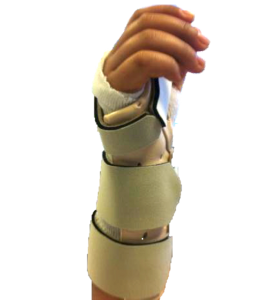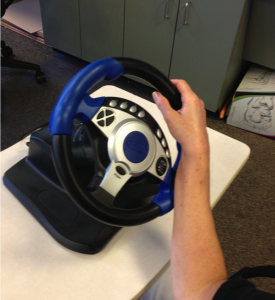
People of all ages can suffer a distal radius fracture (broken wrist) for a wide variety of reasons, from sports injuries on the field to falls and accidents at home.
However, the specific rehabilitation needs of a patient with a broken wrist can also vary widely. Factors such as the severity of the injury, whether or not the dominant hand was injured, the availability of any assistance at home, the presence of comorbidities (two or more simultaneous conditions/impairments), and the job or role expectations the patient must meet all need to be taken into consideration when undergoing physical and/or occupational therapy.
After surgery/treatment of the injured wrist, your orthopaedist will prescribe some type of therapy program to get your wrist back to normal strength, flexibility, and function. While physical and occupational therapy are closely related, there is an important difference.
Physical therapy mainly treats your actual injuries or impairments—occupational therapy also treats impairments and additionally focuses on improving the ability to perform everyday tasks. This include opening a jar, buttoning a shirt, driving a car, caring for a child, as well as performing more specific functions for a job or sports activity.
What to expect on your first visit
Your first visit with an occupational therapist could be right after surgery or after the cast is removed. The decision of when you should start occupational therapy will be made by your treating orthopaedist.
The occupational therapist will perform an initial assessment, which will include:
- Interviewing you to understand specific functional needs and problems performing activities of daily living, roles, and job requirements.
- Reviewing physician notes with you to understand where the fracture was located and how it was treated.
- Reviewing the results of tests (x-rays, MRIs, CT scans) to understand if the fracture is healing, healed, or has a malunion (healed in a suboptimal position).
- Using a tape measure to assess edema (swelling) in the wrist and hand.
- Using a visual analog scale to assess pain.
- Using a goniometer (an instrument for precisely measuring angles) to assess active range of motion of the wrist, forearm, and hand.
- Clearing the shoulder and elbow to make sure there are no restrictions with motion or complaints of pain.
- Discussing what type of range of motion you are cleared to perform by the orthopaedist. This would include active range of motion (moving with no assistance), active assistive range of motion (movement requiring some help), and passive range of motion (movement guided completely by a therapist).
- Understanding what goals you have for returning to the activities and hobbies you enjoy—playing the piano, getting back on the tennis court, knitting, or other things that require a full return of flexibility, strength, and fine motor skills.
- If there are any complaints of numbness or tingling, a sensation test will also be completed.
After the initial assessment is completed, rehabilitation can begin. Rehabilitation after a distal radius fracture consists of two phases.

A volar wrist orthosis
Phase 1—Immobilization
This phase consists of stabilizing the fracture and enabling healing. The role of occupational therapy at this phase includes:
- Fabricating a custom-made orthosis (a support/bracing device) to immobilize the wrist while leaving the fingers free.
- Managing swelling with elevation, retrograde massage, and compression.
- Enabling your return to light activities of daily living as allowed by your orthopaedist.
- Instruction on active range of motion of the proximal and distal joints of the wrist, including the fingers, elbow, and shoulder.
Phase 2—Mobilization
There is no specific time frame as to when this phase can be started. It varies based on how the fracture is treated (surgery vs. no surgery) and/or how well the fracture has healed. A fracture fixated with a plate or pins can move earlier if it is stable.
The role of the occupational therapist in this phase includes:
- Progressing exercises of the wrist and forearm, starting with active range of motion, then active assistive range motion, followed by passive range of motion, and eventually strengthening.
- Continuing active range of motion exercises for the hand and progressing to strengthening.
- Continuing to monitor the shoulder and elbow for pain or stiffness.
- Managing pain with the use of modalities.
- Continuing to manage swelling.
- Practicing light functional and purposeful activities in the hand clinic and progressing the patient to perform daily activities in the home, work activities, and eventually sports and recreational activities.

Patient practicing using a steering wheel after distal radius fracture
Conclusion
Distal radius fractures are commonplace, but they necessitate a careful, expert rehabilitation program to minimize pain, weakness, and swelling, and to ensure proper healing. By entrusting your rehabilitation to an experienced occupational therapist, you’ll be able to return to your daily tasks, recreational activities, and/or job responsibilities earlier.
 Sarah Wilson is an occupational therapist at the SMARTherapy Center at Washington Orthopedics & Sports Medicine, specializing in the evaluation and treatment of injuries and disorders of the upper extremity. She earned her Masters in Occupational Therapy in 2001 from Misericordia University, and is working on her PhD at Nova Southeastern University. Sarah became a Certified Lymphedema Therapist (CLT) in 2005, and a Certified Hand Therapist (CHT) in 2008. She has been with WOSM since 2007.
Sarah Wilson is an occupational therapist at the SMARTherapy Center at Washington Orthopedics & Sports Medicine, specializing in the evaluation and treatment of injuries and disorders of the upper extremity. She earned her Masters in Occupational Therapy in 2001 from Misericordia University, and is working on her PhD at Nova Southeastern University. Sarah became a Certified Lymphedema Therapist (CLT) in 2005, and a Certified Hand Therapist (CHT) in 2008. She has been with WOSM since 2007.
Want to know more?
For more information about wrist injuries and rehabilitation, email us or request an appointment. Be sure to follow us on Facebook and Twitter as well!
